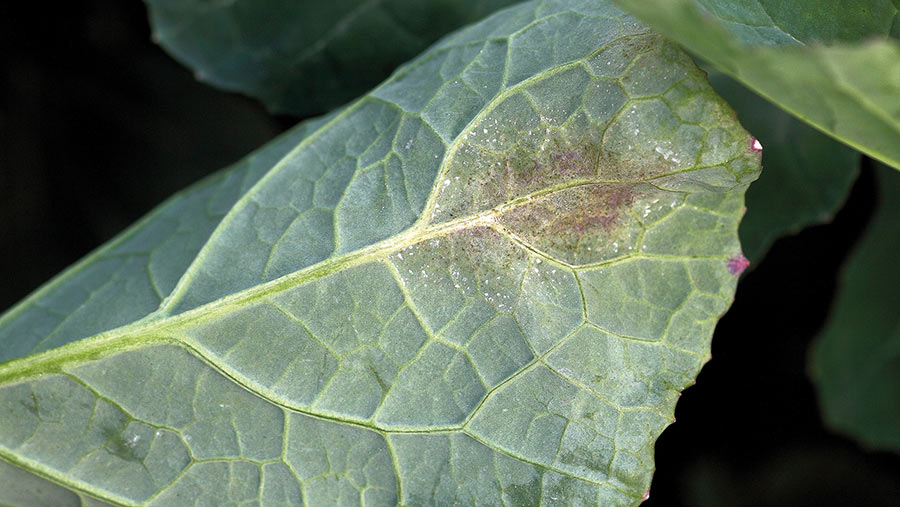Why OSR growers shouldn’t rely on azoles for light leaf spot
 © Tim Scrivener
© Tim Scrivener Oilseed rape growers have been given an early warning about the future effectiveness of light leaf spot sprays, after researchers found that the fungus responsible for the disease is becoming increasingly resistant to azole fungicides.
Work done at Rothamsted Research on light leaf spot populations has shown that complex variants of the gene targeted by azole fungicides are now widespread, with laboratory testing confirming that they are far less sensitive to the chemicals applied.
In addition to the two already-known-about alterations in the CYP51 protein – the target site in azole chemistry – several new ones were confirmed, all of which are associated with reduced sensitivity to the azole group of fungicides.
See also: How data analytics can help identify marginal farmland
As plant pathologist Kevin King of Rothamsted Research explains, the light leaf spot fungus shows especially high genetic diversity, which is why it continues to evolve fungicide resistance.
“We have seen another shift in sensitivity to the azoles in the UK,” he reports. “We will continue to monitor the situation so that we can give the right guidance on the management of the disease. In the meantime, we urge growers to be on the lookout.”
Early detection of any developments is key, stresses Dr King, as it gives time for the researchers to issue advice to growers on how to react.
He adds that there are two bits of good news for oilseed rape growers when it comes to light leaf spot control this autumn.
“Despite the differences in the laboratory, both azole and non-azole products are still performing similarly in the field, and there were no signs of resistance in the other fungicide groups.
“Of course, there’s no reason why resistance couldn’t develop in the SDHIs, for example, but that’s not a concern with light leaf spot at the moment.”
Dr King believes that these latest results support the use of mixtures for robust disease control, so that optimal strategies are being employed. That means mixing azoles with other chemistry.
“Slowing the selection for resistance relies on the use of fungicides that work in different ways,” he says.
“The message for farmers is that azoles are still effective, but they are becoming less so.”
Light leaf spot study
The collaborative study between Rothamsted, Adas and Niab in the UK, Teagasc in Ireland, IHAR-PIB in Poland and Nanjing Agricultural University in China looked at light leaf spot populations throughout Europe.

© Blackthorn Arable
Differences were seen between different European populations – Danish populations were far more sensitive to azoles than either UK or German populations, where azoles have been used widely.
Within the UK, regional variations were identified. Northern populations were less sensitive than southern ones, reflecting the disease’s spread from the colder, wetter parts of the country.
Advice in the field
Light leaf spot is controlled by a combination of factors – with genetic resistance and cultural practices being used in addition to fungicide applications.
Before making any recommendations, most agronomists will consider fungicide use over the whole growing season on the oilseed rape crop, as well as the likely yield responses, says agronomist Will Cobley of Ceres Rural.
“It’s well known that we don’t see a huge response from autumn fungicides in oilseed rape, so there is always a decision to be made about spend,” he adds.
Having said that, given the current high value of the crop it should be looked after, he believes. “Even small responses to fungicides are likely to return a significantly better margin than has been seen for a long time.”
Finding an active that isn’t an azole to use in the autumn is tricky, he continues. “There aren’t many other options. Aviator, an SDHI/azole co-formulation, which is approved for autumn use, tends to be used in the spring at the first sclerotinia spray timing.”
As an autumn spray is usually applied to oilseed rape for both phoma and light leaf spot control, Mr Cobley says prothioconazole has been the preferred choice for most situations up until now, and has continued to perform well.
“It has given good results for an acceptable price. However, we need to consider this heightened resistance threat and make sure that everything else is being done to minimise disease risk.”
The trend to drill oilseed rape earlier, to avoid the peak flea beetle migration period, won’t help where disease development is concerned, he notes.
Unlike phoma, there is no threshold for light leaf spot, with growers being advised to treat if they see it. Incubating a few leaves in a closed plastic bag for 3-4 days will show if the disease is present.
Variety resistance ratings
With the exception of two Clearfield varieties, all of the winter oilseed rape varieties on the AHDB Recommended List have a 6 rating or higher for light leaf spot resistance.
Of this year’s newcomers, UK-wide choice Aviron and East/West recommended DK Expectation are the best for light leaf spot, with a score of 7.

